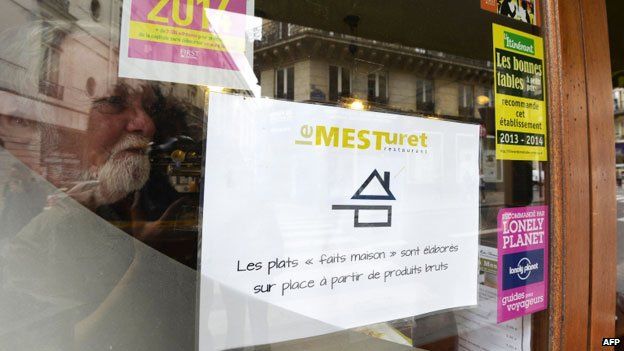The new sign on French menus
- Published

The summer rush to France - a magnet for more foreign tourists than any other country - is about to begin. And this year travellers may spot a new logo on menus, designed to flag up when food has been home-made. But how exactly is "home-made" defined?
The bad news is that - just like anywhere else in the developed world - many French restaurants just reheat pre-prepared food, rather than cooking it from scratch.
French consumers estimated, in a poll last October, that barely half of restaurant meals were home-made, while the Union of Hotel Skills and Industries suggests that 85% of restaurants secretly make use of frozen or vacuum-packed food.
In the country of Parmentier, Escoffier, and Paul Bocuse, to many people this just doesn't seem right, so a law designed to uphold French culinary traditions was passed earlier this year, and came into force this week.
Now any restaurant that serves a home-made dish can indicate it on the menu with a new logo - in the shape of a saucepan with a roof-like lid. From next January it will be compulsory for all menus to carry the logo - so if you don't see it, the food is not fait maison.
"We chose to represent 'home-made' with a logo so that foreign tourists could understand it," says a government spokeswoman.
"French gastronomy represents 13.5% of foreign tourists' expenses and it's undeniable that if we add value to the quality of our restaurants, it will have an impact on tourism."
Even professional chefs in smart restaurants have been cutting corners, it seems.
They can buy steak tartare that has been chopped irregularly to make it look as if it was just hand-prepared in the kitchen, and any number of faux home-made tarts and pies.
"It's true that it is much easier to buy ready-made piecrust or ready-made veal stock. You don't have to come in early or to stay during the afternoon," says Pierre Negrevergne, Maître Restaurateur at La Terrasse Mirabeau in Paris, who only cooks with fresh seasonal products from local producers.
"Anyone can buy a ready-made pate, cut it, present it with some salad and only few people will notice it is industrial."
Alain Tortosa, gourmet and creator of the directory Restaurantsquifontamanger.fr, mentions the case of a chef who went out for dinner and knew he was eating an industrially made Boeuf Bourguignon. "It was so good that the chef was soon asking himself why he was taking the trouble to make his own," he says.
French diners' views
- 81% know that some restaurants use pre-prepared products
- 82% say the use of industrial food by restaurants is incompatible with what they expect
- 73% say they are satisfied with the quality of meals served in restaurants
- 34% would be willing to pay more for a restaurant that serves homemade food
Source: April 2013 survey by Opinion Way for the Union of Hotel Skills and Industries
Under the new law readymade pie crust, pate and stew will not qualify for the logo, but there are some exceptions.
Chefs can buy bread, pasta, cheese and wine, and also, more controversially, raw products that have been frozen, refrigerated, chopped, ground, smoked, or peeled - though this doesn't extend to oven chips.
A number of French commentators are furious.
Food critic JP Gene has lashed out in Le Monde, scoffing at the idea of "home-made" restaurant food produced with frozen shrimps and frozen spinach.
The exceptions undermine the original idea of the law, he argues, which was to allow the consumer to distinguish a restaurant where fresh products are cooked on site, to encourage the use of local produce, and to create jobs - because kitchens need staff if they are to peel their own vegetables, fillet fish and truss chickens.
The result, he says, is a "joke".
The government nonetheless predicts a virtuous circle, with restaurant owners increasing the number of home-made meals, consumers getting a better experience, and visiting restaurants more regularly.
Whether this is how it will work in practice, nobody can be sure.
Francis Attrazic, President of the French Association of Maitres Restaurateurs points out that many restaurants will continue to serve only reheated food, because it's all they know how to do.
He still thinks it's useful, though, to have the concept of "home-made" food defined in law for the first time.
For his part, Alain Tortosa can see the law actually reducing the number of home-made dishes on menus.
He gives the example of a restaurant owner whose menu is almost entirely made with industrial food, except for the apple pie he makes himself. Under the new law, he will have to put a logo next to the pie - but this will only serve to underline the fact that all the other dishes are pre-prepared.
"The restaurant owner will be tempted to replace the home-made pie by a pre-prepared one. He will have less work, he will earn more money and he lawfully won't put any logo on his menu."
Subscribe to the BBC News Magazine's email newsletter to get articles sent to your inbox.